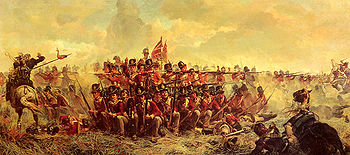
The 28th Regiment at Quatre Bras
Encyclopedia

Oil painting
Oil painting is the process of painting with pigments that are bound with a medium of drying oil—especially in early modern Europe, linseed oil. Often an oil such as linseed was boiled with a resin such as pine resin or even frankincense; these were called 'varnishes' and were prized for their body...
on canvas from 1875, painted by Elizabeth Thompson
Elizabeth Thompson
Elizabeth Southerden Thompson, Lady Butler was a British painter, one of the few female painters to achieve fame for history paintings, especially military battle scenes, at the end of that tradition...
(Lady Butler). The painting is 97.2 centimetres (38.3 in) long and 216.2 centimetres (85.1 in) tall. It is located in the National Gallery of Victoria
National Gallery of Victoria
The National Gallery of Victoria is an art gallery and museum in Melbourne, Australia. Founded in 1861, it is the oldest and the largest public art gallery in Australia. Since December 2003, NGV has operated across two sites...
, Melbourne, Australia.
Thompson based the painting on a book written by Captain William Siborne
William Siborne
William Siborne, Sibourne or Siborn was a British officer and military historian whose most notable work was a history of the Waterloo campaign.-Early life:...
, the History of the War in France and Belgium in 1815, first published in 1844. The painting portrays the 28th (North Gloucestershire) Regiment of Foot
28th (North Gloucestershire) Regiment of Foot
The 28th Regiment of Foot was a British infantry regiment from 1782 to 1881.For their conduct at the Battle of Alexandria in 1801 the 28th were given the unique honour of wearing a badge on both the front and rear of their head dress.. They served throughout the Peninsula War including the battles...
, of the British Army
British Army
The British Army is the land warfare branch of Her Majesty's Armed Forces in the United Kingdom. It came into being with the unification of the Kingdom of England and Scotland into the Kingdom of Great Britain in 1707. The new British Army incorporated Regiments that had already existed in England...
, on 16 June 1815, at the Battle of Quatre Bras
Battle of Quatre Bras
The Battle of Quatre Bras, between Wellington's Anglo-Dutch army and the left wing of the Armée du Nord under Marshal Michel Ney, was fought near the strategic crossroads of Quatre Bras on 16 June 1815.- Prelude :...
. The battle, part of the Waterloo Campaign of the Hundred Days
Hundred Days
The Hundred Days, sometimes known as the Hundred Days of Napoleon or Napoleon's Hundred Days for specificity, marked the period between Emperor Napoleon I of France's return from exile on Elba to Paris on 20 March 1815 and the second restoration of King Louis XVIII on 8 July 1815...
, was just two days prior to the Battle of Waterloo
Battle of Waterloo
The Battle of Waterloo was fought on Sunday 18 June 1815 near Waterloo in present-day Belgium, then part of the United Kingdom of the Netherlands...
. The regiment held off attacks from French cavalry at Quatre Bras
Quatre Bras
Quatre Bras is a common name given to a crossroad in French.More specifically it refers to the crossroad of the Charleroi-Brussels road and the Nivelles-Namur road South of Genappe in Wallonia, Belgium...
. Thompson shows the regiment formed in a square withstanding attacks, at approximately 17:00, from Polish
Poland
Poland , officially the Republic of Poland , is a country in Central Europe bordered by Germany to the west; the Czech Republic and Slovakia to the south; Ukraine, Belarus and Lithuania to the east; and the Baltic Sea and Kaliningrad Oblast, a Russian exclave, to the north...
Lancer
Lancer
A lancer was a type of cavalryman who fought with a lance. Lances were used in mounted warfare by the Assyrians as early as and subsequently by Greek, Persian, Gallic, Han-Chinese, nomadic and Roman horsemen...
s and cuirassier
Cuirassier
Cuirassiers were mounted cavalry soldiers equipped with armour and firearms, first appearing in late 15th-century Europe. They were the successors of the medieval armoured knights...
veterans led by Marshal Ney.
Thompson had uniforms of the period replicated so she could accurately portray them in her painting. However, the shako
Shako
A shako is a tall, cylindrical military cap, usually with a peak or visor and sometimes tapered at the top...
she depicts the regiment wearing is incorrect. Whilst nearly all Regiments of Foot in the British Army had adopted the false fronted Belgic shako (so the replica uniforms were correct for a standard line regiment), the 28th Regiment continued to wear the older 'stovepipe' shakos during the 100 Days Campaign (ending with the Battle of Waterloo), which had been phased out and replaced in 1812 by the aforementioned Belgic kind. Thompson, however, portrayed the soldiers wearing the newer Belgic shako instead. The older headwear can be seen clearly in William Barnes Wollen's painting: 28th Gloucester Regiment at Waterloo.

